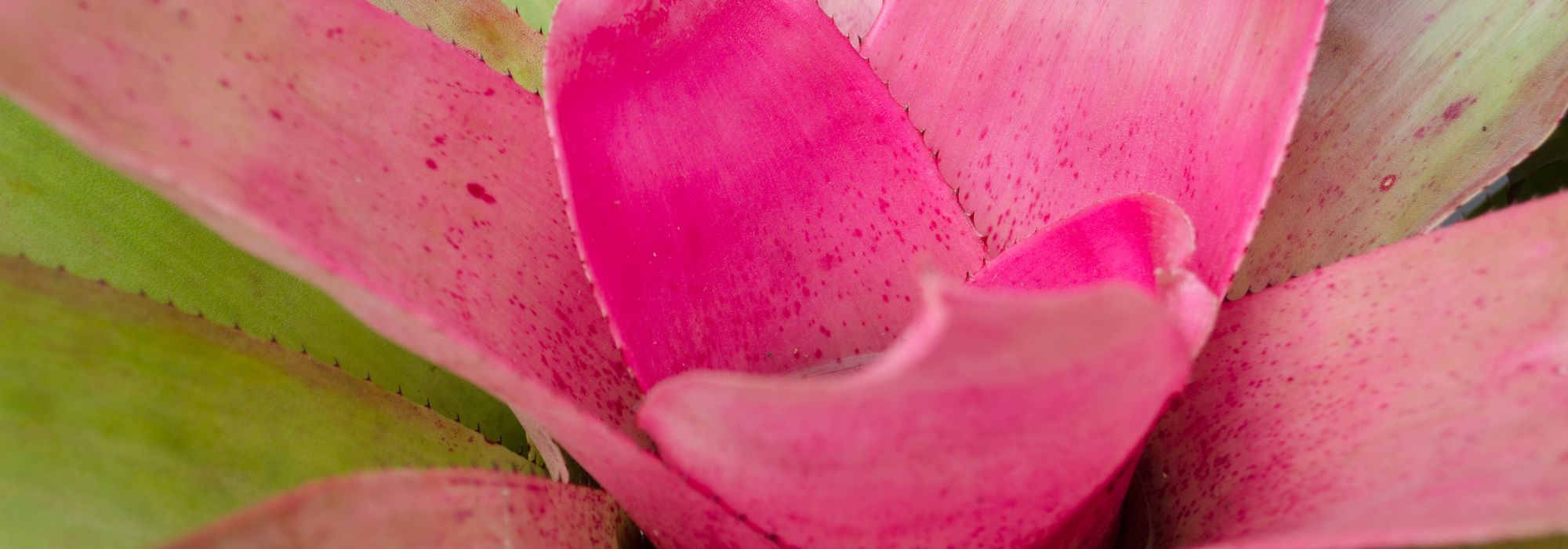
Neoregelia : growing and caring for this bromeliad
Contents
The neoregelia in a few words
- The Neoregelia is a decorative tropical plant from the Bromeliaceae family.
- It forms a colourful rosette that retains water at its centre.
- This reservoir plant thrives in bright indoor settings, in a light and well-draining substrate.
- Its care is straightforward: moderate watering, minimal fertiliser, and no pruning.
- It propagates easily by separating the offsets produced after flowering.
The word from our expert
The Neoregelia is a tropical plant native to South America, belonging to the Bromeliaceae family. Highly prized as a houseplant, it captivates with its compact and colourful rosette, capable of storing water in its centre, hence its common name, the tank plant. Its spectacular foliage, with hues ranging from bright green to deep red, makes it a true botanical gem. It thrives in bright light without direct sunlight, good ambient humidity, and a very well-draining substrate.
Suitable for cultivation in pots or terrariums, the Neoregelia thrives in bright interiors with contemporary, tropical, or minimalist styles. It has neither a trunk nor branches, but a rosette structure that forms a natural reservoir, typical of epiphytic plants. Its root system is underdeveloped, allowing it to be grown in shallow but well-aerated containers. Varieties such as Neoregelia ‘Medusa’, ‘Olena’, or ‘Cotton Candy’ offer a wide range of shapes and colours.
Easy to care for, the Neoregelia requires moderate watering of the substrate and special attention to the rosette, which should be filled with clean water, especially during the growth period. Not very demanding, it can be lightly fertilised in spring and summer. It does not require pruning, but a simple removal of dry leaves is enough to preserve its beauty.
Propagation of the Neoregelia is very easily done by separating offsets, the small shoots that emerge at the base of the mother plant after flowering. By replanting them in a suitable substrate, you quickly obtain new specimens that are just as decorative.
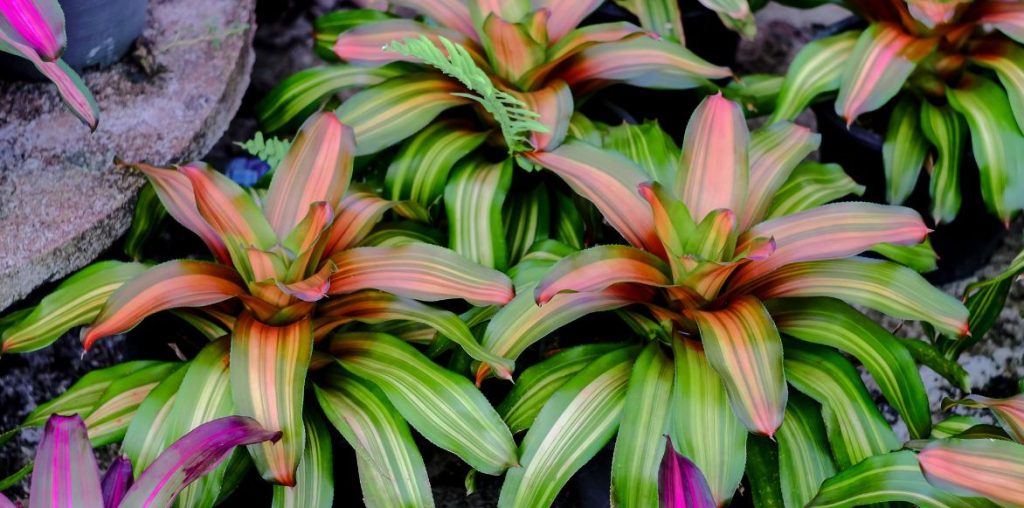
Some varieties of Neoregelia reveal variegated foliage, as seen here with the ‘Fancy’ cultivar
Botany and description
Botanical data
- Latin name Neoregelia sp.
- Family Bromeliaceae
- Common name neoregelia, tank plant, pineapple nest
- Flowering year-round
- Height 20 cm
- Exposure medium to bright light, no direct sunlight
- Soil type epiphytic mix for bromeliads
- Hardiness frost-sensitive
The Neoregelia belongs to the large Bromeliaceae family, famous for other exotic plants with colourful foliage such as the Bromelia, the Guzmania, and… the pineapple. Its name pays tribute to the Swedish botanist Eduard August von Regel, a specialist in tropical plants who contributed to their classification. In French, it is simply called “néorégélie,” although its membership in the bromeliad family sometimes earns it the generic name “tank bromeliad” or simply “tank plant.” It is also occasionally referred to as a “pineapple nest.”
In its natural habitat, this epiphytic* plant thrives in the tropical forests of South America, particularly in Brazil. Clinging to tree trunks and branches, it draws rainwater and nutrients through its rosette foliage, which forms a natural cup at the plant’s centre. This adaptation allows it to survive in environments where the soil is often poor or non-existent.
*An epiphytic plant grows on a support, usually a tree, without being parasitic, absorbing moisture and nutrients from the air and rain.
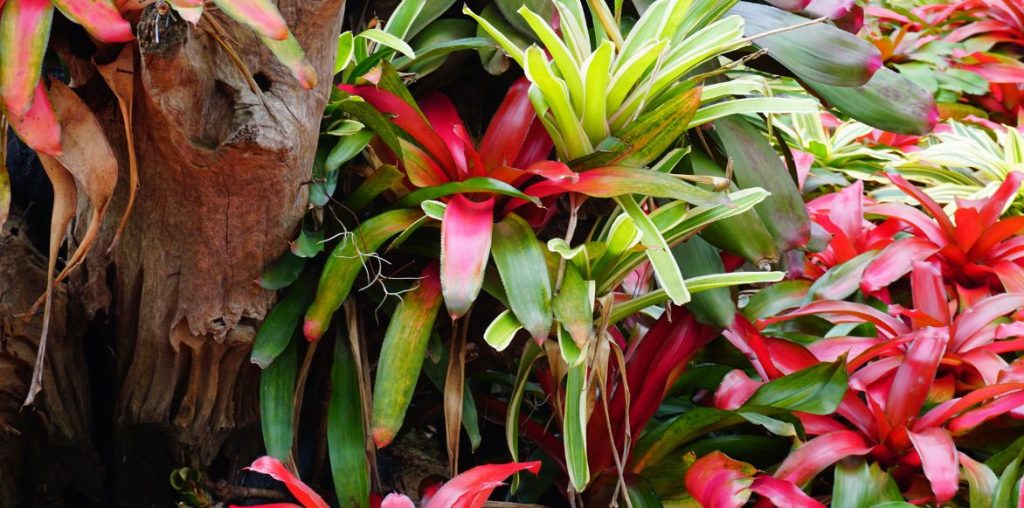
Like many Bromeliaceae, neoregelias are epiphytic plants.
If the Neoregelia is so popular as a houseplant, it’s thanks to its spectacular foliage and relatively simple care. Unlike other bromeliads, it doesn’t rely on showy flowering but on the intense colouring of its central leaves as flowering approaches. Indeed, its graphic foliage is often tinged with red, pink, or purple. The plant also has an astonishing ability to store water in its rosette: a true botanical curiosity.
Among the many cultivated varieties, the Neoregelia ‘Medusa‘ boasts striking foliage streaked with contrasting shades, while the Neoregelia ‘Olena‘ is characterised by a softer, brighter hue. Neoregelia ‘Cotton Candy’, on the other hand, charms with its pastel tones and delicately powdered appearance. These varieties, like many other Neoregelias, are prized for their compact habit and ability to bring a touch of exotic nature without demanding complex care.
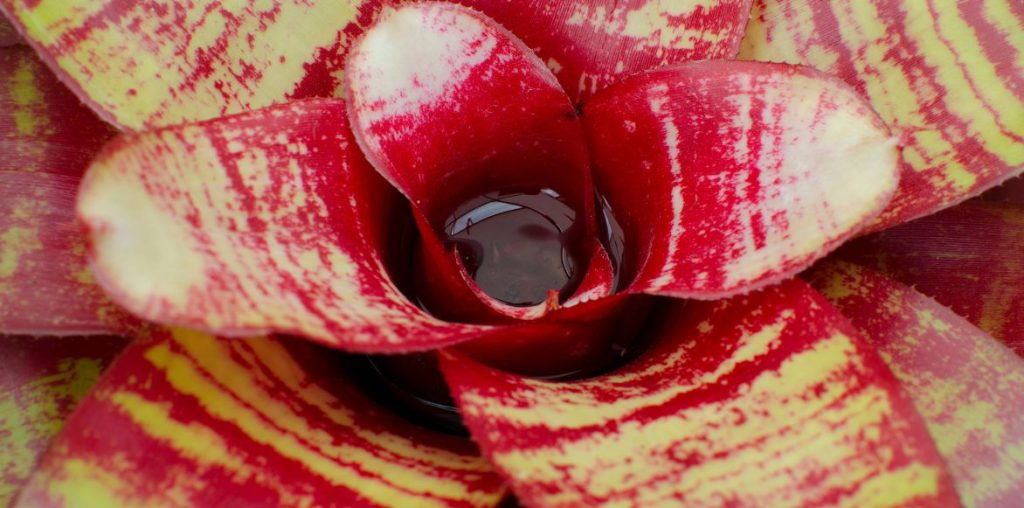
Some cultivars feature marbled foliage.
Plant Morphology
The Neoregelia adopts a compact rosette silhouette, characteristic of bromeliads. Its habit is generally low and spreading, although some varieties may develop a more imposing spread. It has neither a trunk nor branches in the strict sense, as its development is entirely centred on its foliage.
Its root system is modest and primarily adapted for anchoring rather than nutrient absorption. In its natural habitat, it often grows as an epiphyte, clinging to trees with its fine, shallow roots, which serve more as support than a means of nourishment. When potted, these roots remain undemanding but require a light, well-draining substrate to avoid stagnant moisture.
The foliage is the most remarkable feature of this plant. The leaves, rigid and arranged in a spiral, form a dense rosette that plays a vital role in the survival of the Neoregelia. They are edged with small thorns, more or less pronounced depending on the variety, and have a glossy texture that promotes water retention in the plant’s heart. The foliage colouring is particularly spectacular: from deep green to vivid shades of red, pink, or purple, as seen in Neoregelia ‘Fireball’, with scarlet leaves, or Neoregelia ‘Hannibal Lecter’, whose striated patterns evoke reptile skin. This pigmentation becomes even more intense as flowering approaches, a characteristic phenomenon of the genus.
The flowering of the Neoregelia is discreet but fascinating. Unlike other bromeliads that develop a large floral spike, the flowers of the Neoregelia remain nestled in the heart of the rosette, surrounded by coloured inner leaves that highlight them. Small tubular flowers, violet or bluish, briefly emerge at the plant’s centre, immersed in the water held by the rosette. Once flowering is complete, the mother plant begins a slow decline, but it ensures its succession by producing new offsets at its base, guaranteeing the plant’s continuity.
Fruiting is rare in indoor cultivation, as it depends on very specific conditions and pollination often absent outside its natural habitat. In the wild, it may produce fleshy berries containing seeds, dispersed by birds or the water held in the rosette. However, in cultivation, the Neoregelia is mainly propagated by separating offsets.
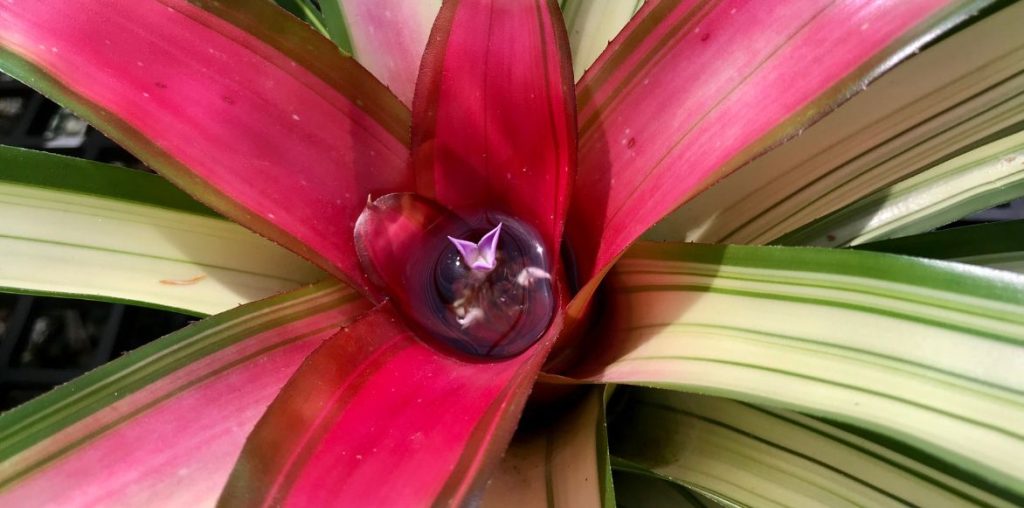
The flowers are very discreet and remain nestled in the heart of the rosette.
Read also
Guzmania: care, planting, and adviceWhen and how to plant a neoregelia in a pot?
When to plant?
The Neoregelia can be planted indoors at any time of the year, but spring and summer remain the ideal periods. The warmth and more abundant natural light promote good hardening and faster root growth.
Which substrate to choose?
As an epiphytic plant, the Neoregelia requires a very well-draining substrate to avoid water stagnation. An ideal mix includes:
- 50% pine bark or coconut fibres for aeration,
- 30% turf or sphagnum moss for moisture retention,
- 20% perlite or coarse sand to improve drainage.
A potting mix designed for orchids or bromeliads can also work, provided it is well-aerated.
Where to place it?
The Neoregelia thrives in bright, indirect light. It can tolerate a few hours of gentle sunlight (morning or late afternoon), but direct, harsh sunlight can scorch its leaves. An ideal spot would be near an east or west-facing window, or under artificial light suitable for tropical plants.
The ideal temperature ranges between 18 and 27°C. Below 15°C, the plant slows its growth and may suffer. Ambient humidity should be high (50 to 70%), which can be achieved with a water tray filled with clay pebbles, a humidifier, or regular misting, especially in winter when indoor heating dries the air.
Which pot to choose?
A shallow but wide pot is preferable, as the Neoregelia’s roots do not require depth. The diameter should be slightly larger than the base of the plant (about 12 to 15 cm for a young plant). The most suitable materials are:
- Plastic pots, which retain moisture better,
- Terracotta pots, which provide better aeration but require more frequent watering.
In any case, the pot must have drainage holes to prevent water retention.
How to pot a Neoregelia?
- Prepare the pot: place a drainage layer at the bottom with clay pebbles or gravel.
- Prepare the substrate: mix the components (see substrate section) to create a light, well-draining medium.
- Position the plant: place your tank plant, ensuring the base of the rosette is slightly above the substrate level to avoid rot.
- Fill and lightly tamp: add substrate around the roots without compacting too much, to avoid suffocating the plant.
- Water lightly: moisten the substrate without soaking it and fill the rosette with a little clean water.
- Place the plant in a bright spot and monitor its adaptation during the first few weeks.
Occasional repotting
The Neoregelia does not require frequent repotting, as its roots remain compact. Repotting can be considered every 2 to 3 years, when the substrate is depleted or if the roots outgrow the pot. This is best done in spring, following the same steps as the initial planting. If the plant has produced offsets, this is also an opportunity to separate and replant them individually.
How to care for a Neoregelia?
Watering
As a tank bromeliad, the Neoregelia requires watering based on two principles: moistening the substrate and filling the rosette.
- Water the substrate moderately, ensuring it remains slightly moist but never waterlogged. In summer, watering every 7 to 10 days is sufficient, while in winter, it can be reduced to once every 2 to 3 weeks.
- Fill the rosette with clean water, ideally non-calcareous (rainwater or filtered water), and replace it regularly to prevent stagnation and the growth of bacteria. It is important to empty and clean the rosette every 15 days, especially in winter, to avoid the risk of rot.
- During periods of intense heat or if the ambient air is dry, regular misting on the foliage helps maintain a good level of humidity.
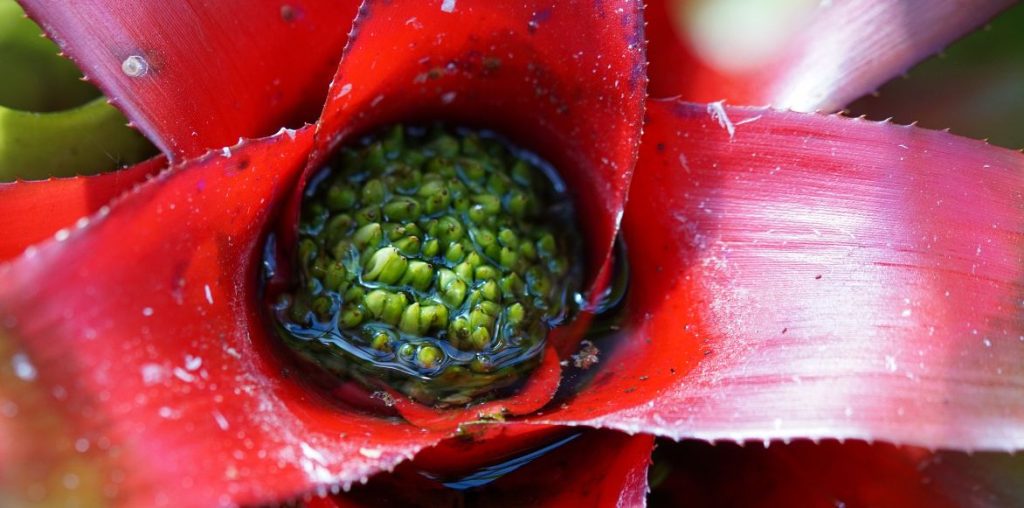
Never forget to pour water into the heart of the rosette.
Fertilisation
As a slow-growing plant that derives most of its nutrients from water and air, the Neoregelia does not require intensive fertilisation.
- A diluted liquid fertiliser, specific to orchids or bromeliads, can be added to the watering water once a month in spring and summer.
- To avoid over-fertilisation, the fertiliser should be highly diluted (two to three times more than the dose indicated on the bottle) and applied directly into the rosette or onto the foliage, rather than into the substrate where the roots absorb little.
- Fertiliser is unnecessary in autumn and winter when the plant slows its growth.
Pruning
The Neoregelia does not require pruning per se, but a little maintenance helps maintain its attractive appearance. This maintenance involves removing dry or damaged leaves at the base of the plant to prevent diseases.
Once flowering is over, the mother plant naturally withers. Simply cut it at the base when it turns completely yellow, allowing the offsets to develop in its place.
Precautions for successful cultivation
A few points of vigilance help avoid common problems:
- Avoid stagnant water in the rosette in winter, as this encourages fungi and rot.
- Do not expose the plant to direct, scorching sunlight, which can cause brown spots on the leaves.
- Maintain good ambient humidity without overwatering, especially in winter when the air is dry due to heating.
Potential Parasitic and Disease Issues in Neoregelia
The Neoregelia can sometimes be targeted by a few parasitic organisms or suffer from certain diseases, especially if the growing conditions are not optimal.
The most common parasites
The enemies of the Neoregelia are quite typical among tropical houseplants:
-
The mealybugs (especially the cottony ones) are undoubtedly the most common. They often settle in the folds of the leaves or at the heart of the rosette. They can be recognised by their cottony appearance. They weaken the plant by sucking its sap and can leave a sticky substance (honeydew) that attracts mould.
-
The aphids may occasionally settle, especially around young shoots or offsets. They are usually green or black and also feed on the sap.
-
The mites (such as spider mites), less visible to the naked eye, cause discolouration and a gritty texture on the leaves. They thrive in dry atmospheres, so maintaining good humidity levels is an excellent preventive measure.
In case of infestation, you can clean the leaves with a damp cloth soaked in soapy water or use a natural treatment like a neem oil solution. For more severe cases, a mild insecticidal spray specific to houseplants can be considered, but only as a last resort.
Possible diseases
Diseases in the Neoregelia are often linked to excess moisture or poor ventilation:
-
Heart rot is probably the most dreaded. It develops when water stagnates for too long in the rosette, especially in cool weather. The base of the leaves then becomes soft and brown, with an unpleasant smell. In this case, you should empty the rosette, cut off the affected parts, and possibly replant a healthy offset if the mother plant is too damaged.
-
Fungi may appear as dark spots on the leaves, often due to excessive humidity or lack of air circulation.
-
Certain bacterial diseases are rare but can manifest as slimy areas or a foul smell. Again, they are encouraged by stagnant water or overly soggy soil.
Daily prevention
To keep a Neoregelia healthy:
-
Regularly empty and clean the water from the rosette,
-
Maintain good humidity levels without overwatering,
-
Ensure good ventilation around the plant,
-
Isolate any new plant before placing it near others to avoid the spread of parasites.
How to propagate the young plant reservoir?
The propagation of the Neoregelia is mainly done through offsets, a natural mode of reproduction. Once the flowering is complete, the mother plant begins to produce small shoots identical to itself at its base. These offsets can be removed to create new young plants.
When to remove the offsets?
Wait until the offsets reach a sufficient size, about one-third of the mother plant’s size, generally around 10 to 15 cm. At this stage, they often already have the beginnings of a root system, which makes it easier for them to establish once separated.
How to proceed?
To remove them, simply gently expose the base of the plant and cut the offset using a clean, sharp tool. It is important to make a clean cut, as close to the stump as possible, without damaging either the mother plant or the offset. Allow the cut base of the offset to dry for one to two days in the open air to promote healing.
Potting the offsets
The offset is then planted in a small pot containing a very well-draining substrate, identical to that used for the mature plant. Lightly firm the soil around the base to stabilise the young rosette, then water moderately without filling the centre of the plant in the first few days.
Bright exposure, without direct sunlight, aids successful establishment. It is also possible to maintain higher ambient humidity initially by placing the pot under a cloche or in a mini greenhouse.
Over the weeks, the offset develops its roots, settles in, and can in turn flower and produce new offsets. It is a natural cycle that, with a little patience, allows you to create a beautiful collection of Neoregelia.
Growing on a natural support (optional)
There is also an alternative for enthusiasts of original cultivation: attach the offset to a natural support such as bark or a piece of cork, maintaining good humidity through regular misting. This type of cultivation more closely resembles the plant’s natural living conditions but requires a bit more daily attention.
The indoor neoregelia: where and how to showcase it?
The Neoregelia thrives in bright interiors where it can enjoy plenty of indirect light. It adapts perfectly to:
-
A contemporary or minimalist interior, where its foliage can add a natural and colourful contrast.
-
A bohemian or tropical décor, where it pairs beautifully with broad-leaved plants, natural materials (rattan, bamboo, linen), and artisanal objects.
-
An urban jungle vibe, surrounded by ferns, philodendrons, or other bromeliads, to create a lush and vibrant green corner.
It loves light, so spots near a well-exposed window but protected from direct sunlight are ideal. A plant shelf, windowsill, or low piece of furniture in a humid room like a bright bathroom is perfect for it.
Which pot or container to choose?
The Neoregelia suits simple yet stylish pots that highlight its foliage without stealing the show:
-
Raw terracotta pots for a natural and warm ambiance,
-
Glazed ceramic cache-pots in solid or pastel colours to accentuate its vibrant hues,
-
Concrete or stoneware pots for a modern and mineral touch.
A shallow but wide pot suits its underdeveloped root system and also highlights the rosette when viewed from above, which is often the most spectacular feature.
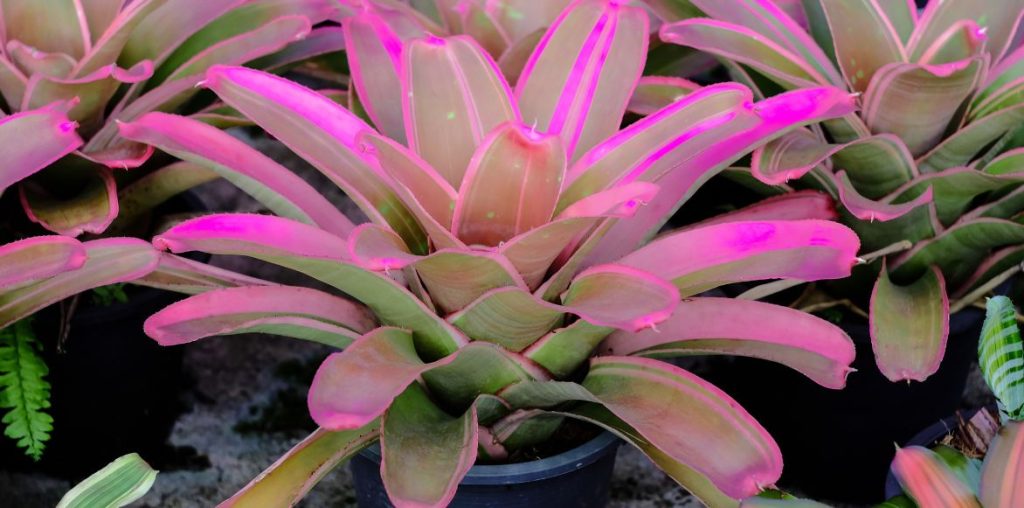
No matter the container, the Neoregelia often stands out on its own.
What about in a terrarium?
The Neoregelia is also an excellent candidate for open or semi-closed terrariums, provided they are spacious and well-ventilated. It works wonderfully in jungle-style tropical terrariums, paired with mosses, natural stones, mini-ferns, or miniature orchids.
Just be careful not to trap too much humidity and ensure sufficient light, otherwise the foliage may lose its shine.
Also worth reading...
→ Discover our wide range of houseplants.
→ Many books on houseplants exist, but we recommend: The Encyclopedia of Houseplants by Solène Moutardier, published by Ulmer.
- Subscribe!
- Contents
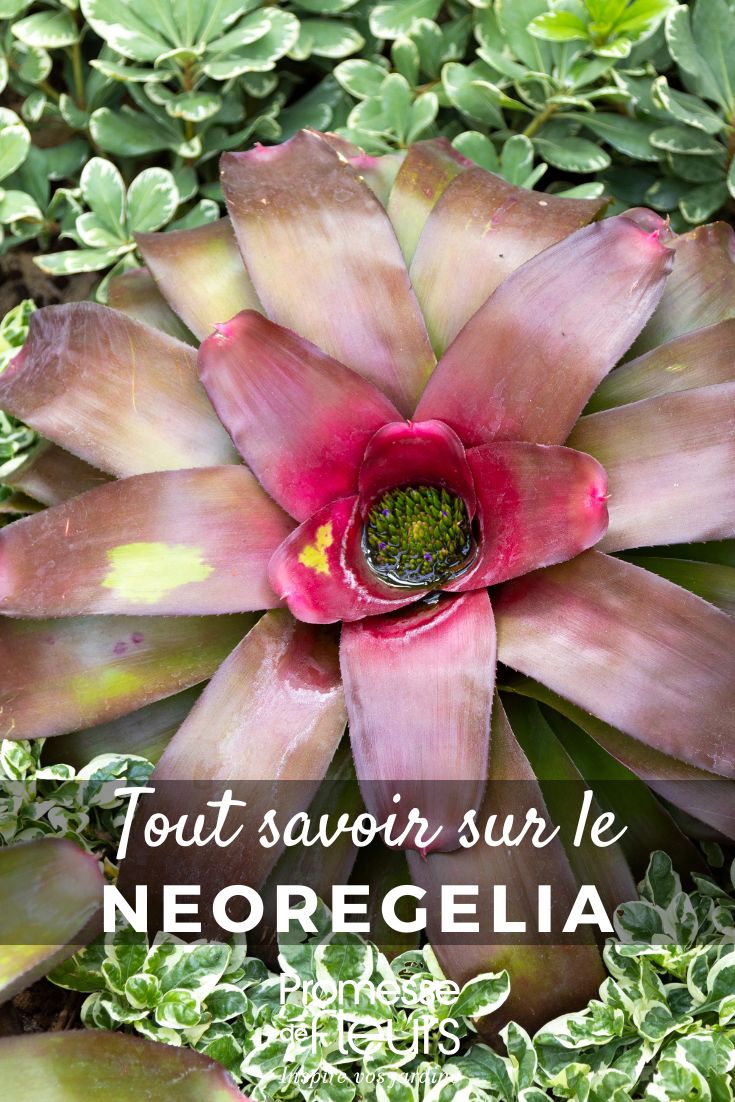































Comments